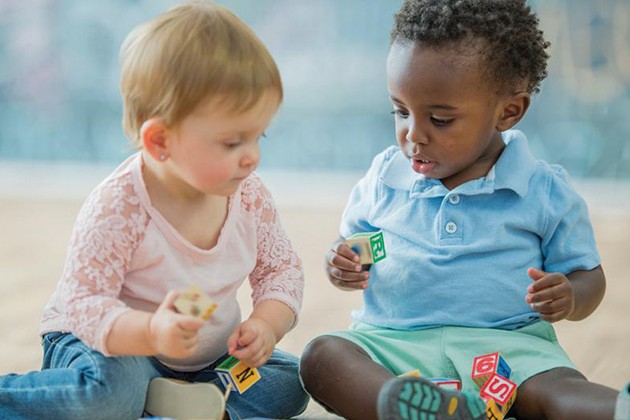Why Babies Need Parallel Play

From the time they’re born, babies are driven by an overwhelming (and, OK, self-centered) desire to eat, cry, coo, giggle, roll over, stare (at you) and swipe at anything that looks remotely appealing.
It’s a me-first existence—but one that will change.
Around the time tots start crawling, and peaking at the 18- to 24-month mark, babies begin to enjoy the company of other cuties as they engage in parallel play, an important activity that helps kids learn how to interact with others.
Typically, in parallel play, kids just share a space, sitting side-by-side or near each other, playing on their own, without talking or interacting. And that’s OK, because at this stage babies and toddlers are content just being around peeps their own size. “It’s a really important step in the play process,” says Tovah P. Klein, Ph.D., author of How Toddlers Thrive, and director of Barnard College Center for Toddler Development, in New York.
Of course, at this stage playdates for kids are less about “play” and more about being in the same zone as other children. “Kids need this experience with peers,” says Rebecca Parlakian, senior director of programs for ZERO TO THREE, a Washington, D.C.-based organization that promotes kids’ well-being. “It’s a step on the path to greater development, but it may not be visible to parents as something special.”
What kids learn from parallel play
When tots share a space, they watch other kids and copy each other’s movements. “The earliest sign that kids are aware of other kids is that they start to imitate one another,” says Klein. “They notice that someone sitting next to them is doing something interesting. They think, ‘I can do that, too.’ For example, if one child in a room rolls out play dough and flattens it with a fist, the other child likely does the same thing,” says Parlakian. “Over time, they’re watching and learning from what they’re seeing.”
Parallel play helps kids acquire social skills needed for cooperative play later. Babies and toddlers are self-involved; they can’t sit for long without moving, and they have little self-control. They grab at toys, don’t know what’s fair and haven’t figured out that others have feelings.
Parallel play gives them a chance to practice social skills—such as empathy and sharing. So look for teachable moments. If your child sees a playmate’s block tower has collapsed, tell your tot, “Ali is sad because her tower fell down. She worked hard on it. Let’s see if she wants to try again.”
Kids this age are slowly finding their way socially, and parallel play helps this process. “Any interaction promotes the ability to interact,” says Lorraine McCune, professor, Educational Psychology, and director of the Infant/Early Childhood Specialist Certificate Program at Rutgers University Graduate School of Education in New Brunswick, NJ.
Get-togethers can frustrate kids at first. “Parallel play supports early friendship skills, but it often unfolds in ways that don’t look friendly,” says Parlakian. But even if playdates get off to a rocky start, kids can learn the basic rules of friendship. Use the time to model pro-social behavior. Tell your child, “Don’t hit.” “Don’t grab.” “Remember to ask your friend, ‘May I have a turn?’ or ‘Can we share that?’” Parlakian suggests you coach your child like this: “Martin, I know you want to play with Ella’s train. Here’s a train for you. Let’s follow Ella’s train around the track.”
How to promote parallel play
To get your child involved in parallel play, create an intimate setting. “Two is a crowd for a toddler,” says Klein. “Less is more.” Set up multiples of toys or activities. That way, kids can play near each other with fewer squabbles. Think play dough, trains, blocks, dolls, dress-up clothes and water tables. And keep your eye on the clock. “Don’t expect it to last all afternoon,” says Klein. “An hour is a long time for two toddlers, especially if they’re inside. They’ll get overstimulated quickly.”
Inspire an early love of reading for ages 0 to 2. Enjoy meaningful time together and introduce babies and toddlers to their world. It’s never too early!









